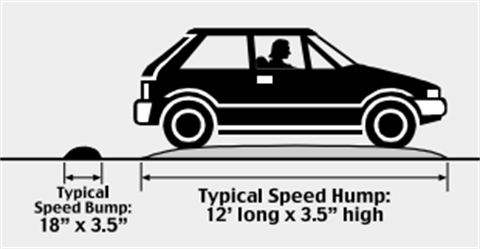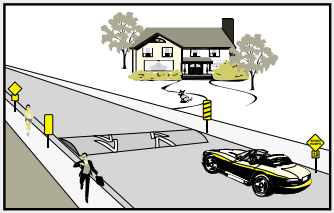Speed Humps

What Is a Speed Hump?
The difference between a speed bump and a speed hump, showing the standard City of Tucson hump dimensions. The city does not allow speed bumps.
What Is the Difference Between a Speed Hump, a Speed Table, and a Speed Bump?
- Speed humps are nationally accepted, and are used on residential streets. A speed hump is 12’ wide and 3” to 3 1/2” high.
- Speed tables are nationally accepted, and are used on secondary emergency streets when the Fire Department has determined that speed humps are not appropriate. A speed table is 22’ wide and 3” to 3 1/2” high.
- Speed bumps are prohibited on local streets, and are used exclusively in shopping centers, apartment complexes, and other private properties. A speed bump is 2’ to 3’ wide and 4” to 6” high.
What Is the Purpose of a Speed Hump?
The purpose of a speed hump is to reduce the speed of vehicles on residential streets where speeding is occurring. They are not designed to change the volume of traffic on residential streets, and do not significantly reduce cutthrough traffic.

How Effective Are Speed Humps?
In The City of Tucson, speed humps have been shown to be very effective in reducing the speed of vehicles traveling on residential streets. Recent speed hump studies have shown a 40-60% reduction in vehicles exceeding the speed limit.
How Does a Citizen Have Speed Humps Installed In Their Neighborhood?
- A neighborhood or an association representative fills out the Speed Hump Request Form
- A petition form and highlighted neighborhood map will be sent to the mailing address provided.
- Petitions are filled out and require 60% approval signatures from neighbors on abutting streets.
- The petition is then be scanned and emailed to, neighborhoodtraffic@tucsonaz.gov or taken to, ATTN: NTMP 201 N Stone Avenue – 5th Floor.
- DTM will conduct a study on approved applicants.
- If the street is approved for construction the contact/liaison will be notified. (If your street is denied an explanatory email will be sent.)
- Approved applicants will receive an email with a payment link.
- Once payment has been received a date for construction will be established and relayed to applicants.
Please Note:
- Residents may request speed humps, but need to pay for the permit and installation cost.
- Speed humps/tables can be added at the price of $4,500-$5,000 per speed hump and $5,000-$5,800 per speed table.
- Some speed humps may not be approved due to potential flooding issues or other circumstances.
How Many Speed Humps Do You Install on a Street?
The number of speed humps installed on a street depends on the length of the street. For speed humps to be effective, they must be installed in a series, approximately 400’ to 600’ apart. One speed hump alone is not advised–they are used as a system.
Disadvantages:
- Emergency response vehicles may be delayed between 2 to 10 seconds per speed hump.
- Emergency response vehicles may be delayed between 2 to 10 seconds per speed hump. Noise levels may increase when vehicles drive over the speed hump.
- The motorist may tend to drive closer to the curb to have only one side of the car go over the speed hump.
Who Pays For Speed Humps?
The installation of speed humps is paid for by the residents themselves. The residents can pay for the speed humps through contributions.
Estimate cost are about $4,500-$5,000 per speed hump and $5,000-$5,800 per speed table. Cost may vary according to individual contractor. Contractor are responsible for the installation of asphalt, thermal striping, signs, permits, blue stake, object markers and RPMs.
Speed Hump Program
The Mayor and Council approved creating a Speed Hump (SH) Program that would reduce the costs for speed hump installations in residential areas throughout the city. Prior to the Speed Hump Program, costs to residents per speed hump were on average $5,000, which covered the costs to hire a contractor, the materials, and the signs. The SH Program reduced this cost to residents to $500 per speed hump, for up to 30 installations City-wide, with Tucson Transportation and Mobility Department Streets Division doing the installations instead of hiring outside contractors
Each Council Office has the authority to award up to 5 speed hump installations per Ward.
Applications may be obtained through the Tucson Transportation and Mobility Department’s Neighborhood Traffic Management Program (NTMP)
Neighborhood Traffic Management Program
Speed Hump Request Form